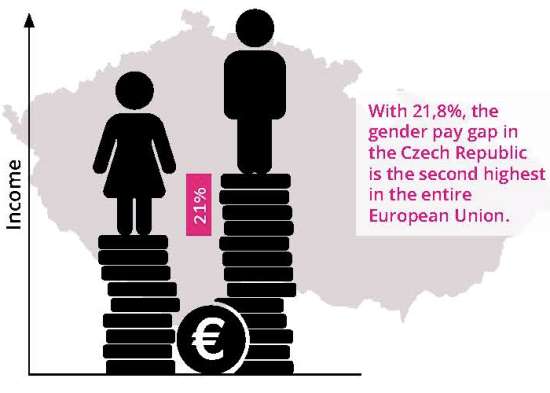Inequalities in Czech Republic
Ondřej Lánský, Social Watch; Stanislava Tomková, Czechia Against Poverty and Inequalities
Income and wealth
The Czech Republic has enjoyed steady economic growth, low inflation and low unemployment in recent years. Income inequality (Gini coefficient 0.25) is the third lowest among OECD countries. In 2018 the proportion of citizens at risk of income poverty (relative poverty - with an income of 60% or less of the national median) were about 10% of the population, while those in absolute poverty (‘materially deprived’) were 8% of the population. Older citizens (65+ years) are worse off than other age groups. In 2018, 10% of households with children (30% of which were single- adult households - single mother or single father) found themselves in income poverty. Furthermore, the Czech Republic has one of the highest proportions of homeless people in the European Union (0.65 % of the population).
Debt enforcement and its impacts on poverty and deprivation is a particular manifestation of income inequality. It is further a consequence of bad political decisions made by previous governments. Overall, a combination of several factors, in particular the transfer of enforcement of court decisions to private bailiffs and the emergence of completely unregulated non-banking companies has resulted in almost 10% of the Czech population somehow affected by enforcement proceedings. If we include family members, around 2.5 million people – a quarter of the population are affected by these proceedings.
In 2017, 863,000 citizens faced enforcement proceedings (a year-on-year increase of almost 3.5 %), with 493,000 people facing three or more enforcement proceedings. 6,000 children under 18 have been subject to enforcement proceedings as well as more than 120,000 older persons over 60 leaving receiving minimum income despite the fact that it is stipulated by law they cannot be subject to enforcement.
Researchers have identified 606 socially excluded localities and 700 shelters in 297 cities and municipalities (small areas with a total population ranging from 95,000 and 115,000) with heavy concentrations of unemployment and indebted people. The majority of people living in the excluded localities are Roma, which proves the interlinkages of poverty, social exclusion and indebtedness to ethnic discrimination.
Gender pay gap in the Czech Republic
 |
Gender
Women are worse off than men in almost all aspects of life – with the exception of longevity. Women in the Czech Republic earn on average 21.8% less than men; 64% of women are in paid work, compared to 79% of men. Women take on a disproportionate share of caring responsibilities, accounting for nearly three quarters of persons who are economically inactive because they are caring for someone else. Very few men stay at home to look after children or other family members. In addition, women are more likely than men to be in part-time employment – 11% of employed women work part-time compared to 2% of men. Women have smaller pensions than men – CZK 10,756 compared to CZK 13,076 (82%). Men outnumber women by five to one on the boards of publicly owned companies. There is a slight imbalance in education with 95% of men having completed upper secondary level education compared to 92% of women. Female university graduates find it harder to find work than men – in 2017 85.5% of female graduates were in employment compared to 95.2% of male graduates.
Health
The Czech health-care system, based on compulsory statutory health insurance, provides virtually universal coverage and a broad range of benefits. It does so at 7.7% of GDP (2012) – well below the EU average – of which 85% was publicly funded. Life expectancy at birth has been steadily rising over the past two decades: rates are now 76 years for men and almost 82 years for women. One challenge for the future is the Czech Republic’s heavy dependence on coal as it has several negative environmental and health effects such as on air quality.
Development cooperation
Official Development Assistance of the Czech Republic (2016) accounted for around 0.14% of the GDP which is below the target of 0.33% set for European member states that joined after 2002. There are further concerns about the aid quality as well as the lack of a monitoring system for aid effectiveness.
Structural causes
The structural causes of inequalities in the Czech Republic are strongly related to the unequal status of women, ethnic discrimination and the education system and employment in general. The debt enforcement system, with hundreds of unregulated companies providing consumer credit to the public, has contributed significantly to income inequality.
Example of good practice
Rapid Rehousing project of Brno city council provides apartments for homeless people or families previously living in hostels. The project favours Roma families but was recently stopped by the newly elected mayor of Brno.
Recommendations
- Reduce gender inequalities, in particular, unfair remuneration and inequitable old-age retirement pensions.
- Protect marginalised and disadvantaged groups against discrimination and prejudices.
- Introduce legislation to reform debt enforcement proceedings with an emphasis on ‘child debtors’.
- Adopt legislation to address social housing needs.
- Reinstate a ministry dealing with human rights and equal opportunities.
- Increase the Czech ODA to at least 0.33% of GDP.
The full version of this report is available here.

